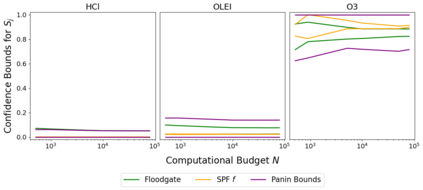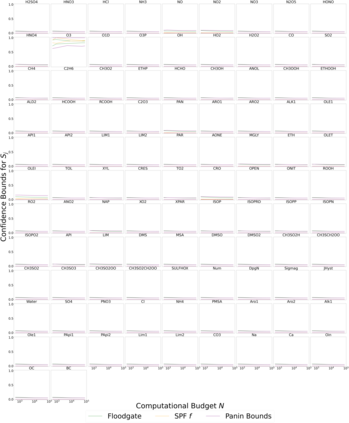Computational models are utilized in many scientific domains to simulate complex systems. Sensitivity analysis is an important practice to aid our understanding of the mechanics of these models and the processes they describe, but performing a sufficient number of model evaluations to obtain accurate sensitivity estimates can often be prohibitively expensive. In order to reduce the computational burden, a common solution is to use a surrogate model that approximates the original model reasonably well but at a fraction of the cost. However, in exchange for the computational benefits of surrogate-based sensitivity analysis, this approach comes with the price of a loss in accuracy arising from the difference between the surrogate and the original model. To address this issue, we adapt the floodgate method of Zhang and Janson (2020) to provide valid surrogate-based confidence intervals rather than a point estimate, allowing for the benefit of the computational speed-up of using a surrogate that is especially pronounced for high-dimensional models, while still retaining rigorous and accurate bounds on the global sensitivity with respect to the original (non-surrogate) model. Our confidence interval is asymptotically valid with almost no conditions on the computational model or the surrogate. Additionally, the accuracy (width) of our confidence interval shrinks as the surrogate's accuracy increases, so when an accurate surrogate is used, the confidence interval we report will correspondingly be quite narrow, instilling appropriately high confidence in its estimate. We demonstrate the properties of our method through numerical simulations on the small Hymod hydrological model, and also apply it to the more complex CBM-Z meteorological model with a recent neural-network-based surrogate.
翻译:在许多科学领域使用计算模型模拟复杂系统。 感知分析是一个重要的做法,有助于我们理解这些模型的机理和它们所描述的过程,但进行足够数量的模型评估以获得准确的灵敏度估计往往成本极高。 为了减少计算负担,一个共同的解决方案是使用一种替代模型,该模型可以合理地接近原始模型,但成本的一小部分。然而,作为替代基于敏感度分析的计算效益的交换,这一方法的前提是,由于代用模型和原模型之间的差别而导致准确性损失。为了解决这一问题,我们调整张和扬森(202020年)的洪门方法,以获得准确性估计,以提供有效的以假设为基础的信任间隔,而不是点估计,允许使用一个对高度模型来说特别明显的代用加速的代用模型,同时保持全球对原始(非代用模型)模型的精确度的精确度的精确性。我们的信心间隔期是,我们用来在精确度的深度模型上显示其精确度,在精确度上,在精确度模型上,在精确度上,在精确度模型上,在精确度上,在精确度模型上,我们用来计算时,我们将的精确度报告中的精确度报告将会显示。









